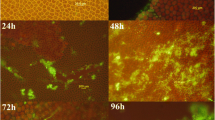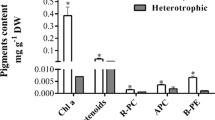Abstract
To investigate the ability to accumulate polyhydroxyalkanoates (PHA) using either acid-treated or un-treated red algae (Gelidium amansii) as a carbon source, a total of six Bacillus megaterium strains were tested. All strains were able to grow considerably when acid-treated algae were used, where strain KCTC 3712 reached highest total dry cell weight (DCW) of 4.1 g/L with a PHA content of 30%. Strain KCTC 2194 accumulated highest PHA of 55% with a total DCW of 3.3 g/L from treated algae. By using un-treated G. amansii as a carbon source, weak growth was observed in all strains. Strains KCTC 1366 and KCTC 3007 reached DCWs of 2.0 and 1.2 g/L and PHA contents of 23 and 27%, respectively, from un-treated algae. This is the first report on PHA production from acidtreated and un-treated red algae.
Similar content being viewed by others
References
Wang, Y., J. Yin, and G. Q. Chen (2014) Polyhydroxyalkanoates, challenges and opportunities. Curr. Opin. Biotechnol., 30: 59–65.
Suriyamongkol, P., R. Weselake, S. Narine, M. Moloney, and S. Shah (2007) Biotechnological approaches for the production of polyhydroxyalkanoates in microorganisms and plants -a review. Biotechnol. Adv., 25: 148–175.
Anderson, A. J. and E. A. Dawes (1990) Occurrence, metabolism, metabolic role, and industrial uses of bacterial polyhydroxyalkanoates. Microbiol. Rev., 54: 450–472.
Kadouri, D., E. Jurkevitch, Y. Okon, and S. Castro-Sowinski (2005) Ecological and agricultural significance of bacterial polyhydroxyalkanoates. Crit. Rev. Microbiol., 31: 55–67.
Posada, J. A., L. E. Rincón, and C. A. Cardona (2012) Design and analysis of biorefineries based on raw glycerol: addressing the glycerol problem. Bioresour. Technol., 111: 282–293.
Park, J. H., J. Y. Hong, H. C. Jang, S. G. Oh, S. H. Kim, J. J. Yoon, and Y. J. Kim (2012) Use of Gelidium amansii as a promising resource for bioethanol: A practical approach for continuous dilute-acid hydrolysis and fermentation. Bioresour. Technol., 108: 83–88.
Wu, Q., H. Huang, G. Hu, J. Chen, K. P. Ho, and G.Q. Chen (2001) Production of poly-3-hydroxybutyrate by Bacillus sp. JMa5 cultivated in molasses media. Anton. Leeuw., 80: 111–118.
Doi, Y. (1990) Microbial Polyesters. VCH Publishers, NY, USA.
Lee, S. Y., J. Choi, and H. H. Wong (1999) Recent advances in polyhydroxyalkanoate production by bacterial fermentation: Mini-review. Int. J. Biol. Macromol., 25: 31–36.
Chen, G. Q. and Q. Wu (2005) The application of polyhydroxyalkanoates as tissue engineering materials. Biomaterials, 26: 6565–6578.
Valappil, S. P., S. K. Misra, A. R. Boccaccini, T. Keshavarz, C. Bucke, and I. Roy (2007) Large-scale production and efficient recovery of PHB with desirable material properties, from the newly characterised Bacillus cereus SPV. J. Biotechnol., 132: 251–258.
Kanjanachumpol, P., S. Kulpreecha, V. Tolieng, and N. Thongchul (2013) Enhancing polyhydroxybutyrate production from high cell density fed-batch fermentation of Bacillus megaterium BA-019. Bioproc. Biosyst. Eng., 36: 1463–1474.
Kulpreecha, S., A. Boonruangthavorn, B. Meksiriporn, and N. Thongchul (2009) Inexpensive fed-batch cultivation for high poly(3-hydroxybutyrate) production by a new isolate of Bacillus megaterium. J. Biosci. Bioeng., 107: 240–245.
Ra, C. H., G. T. Jeong, M. K. Shin, and S. K. Kim (2013) Biotransformation of 5-hydroxymethylfurfural (HMF) by Scheffersomyces stipitis during ethanol fermentation of hydrolysate of the seaweed Gelidium amansii. Bioresour. Technol., 140: 421–425.
Nayak, P. K., A. K. Mohanty, T. Gaonkar, A. Kumar, S. N. Bhosle, and S. Garg (2013) Rapid identification of polyhydroxyalkanoate accumulating members of Bacillales using internal primers for phaC gene of Bacillus megaterium. ISRN Bacteriol., 2013: 562014.
Yun, J. H., S. S. Sawant, and B. S. Kim (2013) Production of polyhydroxyalkanoates by Ralstonia eutropha from volatile fatty acids. Korean J. Chem. Eng., 30: 2223–2227.
Full, T. D., D. O. Jung, and M. T. Madigan (2006) Production of poly-beta-hydroxyalkanoates from soy molasses oligosaccharides by new, rapidly growing Bacillus species. Lett. Appl. Microbiol., 43: 377–384.
Shahid, S., R. Mosrati, J. Ledauphin, C. Amiel, P. Fontaine, J. L. Gaillard, and D. Corroler (2013) Impact of carbon source and variable nitrogen conditions on bacterial biosynthesis of polyhydroxyalkanoates: Evidence of an atypical metabolism in Bacillus megaterium DSM 509. J. Biosci. Bioeng., 116: 302–308.
McCool, G. J. and M. C. Cannon (1999) Polyhydroxyalkanoate inclusion body-associated proteins and coding region in Bacillus megaterium. J. Bacteriol., 181: 585–592.
McCool, G. J. and M. C. Cannon (2001) PhaC and PhaR are required for polyhydroxyalkanoic acid synthase activity in Bacillus megaterium. J. Bacteriol., 183: 4235–4243.
Eppinger, M., B. Bunk, M. A. Johns, J. N. Edirisinghe, K. K. Kutumbaka, S. S. K. Koenig, H. H. Creasy, M. J. Rosovitz, D. R. Riley, S. Daugherty, M. Martin, L. D. Elbourne, I. Paulsen, R. Biedendieck, C. Braun, S. Grayburn, S. Dhingra, V. Lukyanchuk, B. Ball, R. Ul-Qamar, J. Seibel, E. Bremer, D. Jahn, J. Ravel, and P. S. Vary (2011) Genome sequences of the biotechnologically important Bacillus megaterium strains QM B1551 and DSM319. J. Bacteriol., 193: 4199–4213.
Wi, S. G., H. J. Kim, S. A. Mahadevan, D. J. Yang, and H. J. Bae (2009) The potential value of the seaweed Ceylon moss (Gelidium amansii) as an alternative bioenergy resource. Bioresour. Technol., 100: 6658–6660.
Magill, N. G., A. E. Cowan, D. E. Koppel, and P. Setlow (1994) The internal pH of the forespore compartment of Bacillus megaterium decreases by about 1 pH unit during sporulation. J. Bacteriol., 176: 2252–2258.
Sun, Z., J. A. Ramsay, M. Guay, and B. A. Ramsay (2007) Carbon-limited fed-batch production of medium-chain-length polyhydroxyalkanoates from nonanoic acid by Pseudomonas putida KT2440. Appl. Microbiol. Biotechnol., 74: 69–77.
Follonier, S., B. Henes, S. Panke, and M. Zinn (2012) Putting cells under pressure: A simple and efficient way to enhance the productivity of medium-chain-length polyhydroxyalkanoate in processes with Pseudomonas putida KT2440. Biotechnol. Bioeng., 109: 451–461.
Author information
Authors and Affiliations
Corresponding author
Rights and permissions
About this article
Cite this article
Alkotaini, B., Sathiyamoorthi, E. & Kim, B.S. Potential of Bacillus megaterium for production of polyhydroxyalkanoates using the red algae Gelidium amansii . Biotechnol Bioproc E 20, 856–860 (2015). https://doi.org/10.1007/s12257-015-0205-y
Received:
Revised:
Accepted:
Published:
Issue Date:
DOI: https://doi.org/10.1007/s12257-015-0205-y




